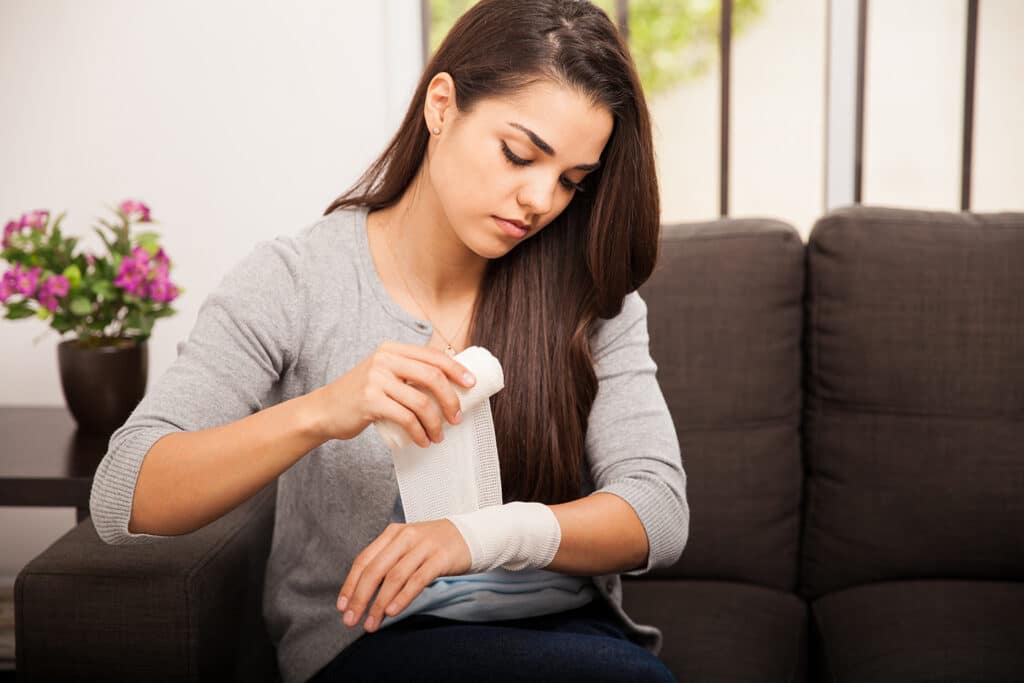Should I cover blisters from poison ivy, poison oak, and poison sumac rash?

So you've had a run-in with poison ivy, poison oak, or poison sumac, and your skin is itching. You’re covered in blisters on your arms, legs, and maybe even neck. Do you know what to do? How should you treat the blisters? Should you pop them or not? Are there any remedies that can make them go away more quickly?
You've probably heard mixed recommendations on how you should take care of them. Most agree that your first step is to wash the affected area with water to remove any oils on the skin's surface. But should you cover the blisters? This post will discuss how you handle poison oak, poison ivy, and poison sumac blisters and the best way to treat their rashes.
Overview of poison ivy, oak, and sumac
Poison ivy, oak, and sumac are all related poisonous plants. Poison ivy (Toxicodendron radicans) is the most common of these. These plants have concentrated oils, called urushiol, found in all parts of the plant that can cause an allergic reaction if they come in contact with your skin. These plants can cause a skin rash called urushiol-induced contact dermatitis.
The rash is not contagious and cannot spread from person to person. But, the oil can stay on your clothes, pet's fur, or gardening tools for a long time. If you touch something with the oil and then touch your skin, you can get a rash. It takes 12 to 48 hours after contact with the plant before symptoms appear. The severity and duration of the reaction depend on how much urushiol is in contact with your skin and how sensitive you are to it.
How do you treat blisters from poison ivy, oak, and sumac?
Blisters are a common immune response of our body when we react to urushiol oil in poison ivy, oak, and sumac. The blisters appear at the spot where the plant made contact with the skin, which is usually on exposed areas such as forearms, legs, and faces. Blisters can also appear in other areas after touching clothing or an object with urushiol on it.
When we touch poison ivy, oak, and sumac, our body can react by releasing histamines, which cause the skin to become red and bumpy (the bumps are called wheals). The blisters that form are due to the skin's natural reaction to being irritated—it swells up to protect against further damage. And because the oil can stay on your skin after exposure, new blisters can continue to form as your body keeps reacting.
Treatment for unpopped blisters from poison ivy, oak, and sumac
Popping blisters is tempting, but it can lead to infection and scarring. The best thing you can do is leave them alone and loosely cover them with a bandage or clean cloth for protection. Follow these easy steps to take care of your unpopped blisters:
- Clean your hands thoroughly before starting treatment.
- Carefully wash the rash gently with Tecnu Original Cleanser or Tecnu Extreme Poison Ivy Scrub using mild circular motions and a clean wash cloth.
- Dry the area using a clean towel or tissue.
- Then, apply Tecnu Calagel Anti-Itch Gel as needed to relieve itching before covering with a bandage or clean cloth.
Treatment for popped blisters from poison ivy, oak, and sumac
The classic image of a popped blister looks similar to a large whitehead with some redness around it, and it's typically flat or slightly raised. If your blisters are already popped, follow these easy steps.
- Clean your hands thoroughly before starting treatment.
- Wash the area with Tecnu Original Outdoor Skin Cleanser by gently massaging it into your skin for two minutes. This removes the urushiol oil and prevents further spreading so you won't have to worry about it spreading to other parts of your body when you touch yourself later.
- Rinse with cool water. Avoid hot or warm water as it can irritate the rash and make it itch even more.
- Dry off by patting down with a towel (don't rub). Since you're treating a popped blister, you don't want to further irritate the skin by rubbing a towel over your skin. Instead, let the towel soak up any remaining moisture.
- While your skin is still damp (but not wet), apply Tecnu Calagel Medicated Anti-Itch Gel to relieve itching and burning sensations caused by poison ivy, oak, and sumac rashes. Make sure you don't use too much gel; a thin layer should be sufficient to cover the affected areas of your body.
- Cover it with a loose gauze pad.
Remember, if a blister pops or is removed by scratching or picking, the area will heal and develop a crust. This crust can last for two weeks or more as it heals.
Prevention from poison ivy, oak, and sumac
The best defense against blisters is prevention, so take care of your skin before there's a problem! There are some great tips to prevent getting poison ivy, oak, or sumac sap on you:
- Wear long pants, long sleeves, shoes, and socks to cover as much skin as possible when hiking in wooded areas where these plants grow.
- When you're hiking near a known area where these plants are, do not touch anything that looks like it has any of these plants growing nearby (leaves, stems, roots).
- Wash your hands after touching anything that could have poison ivy, oak or sumac on it or after coming into wooded areas where these plants usually grow.
- Keep your dog on a leash so they don't run into these poison plants while playing outside.
Don't let an itch or a patch of poison ivy, oak or sumac ruin your hike or work. Be prepared with Tecnu Outdoor Solutions.
Conclusion
The best treatment for these rashes is to avoid these plants, but there's still a chance that the oil will get on your hands. If you know you're going to be spending time in the woods, it's worth it to carry some first aid in your backpack. To know more about how you can have a rash-free hike, visit our store now!




